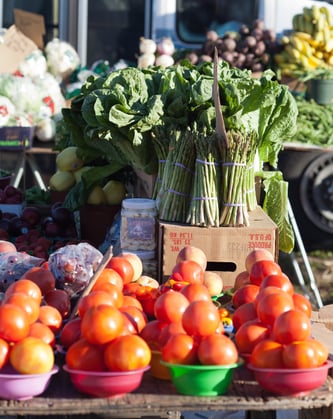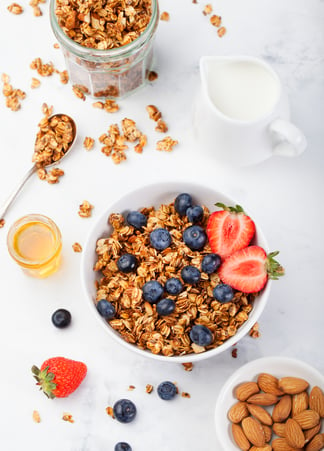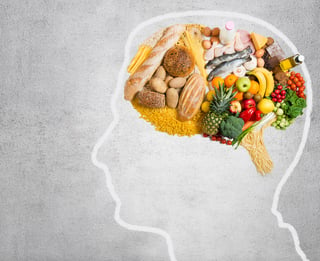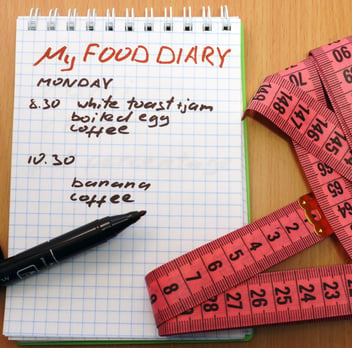One of my favorite things to do during summer in Indiana is to visit the various farmers’ markets around town. As a dietitian I am a sucker for the fresh fruits and veggies, but I also love the homemade desserts, candles, pasta, kettle corn, fresh flowers, and other wonderful items you can find.
The Top 5 Reasons to Shop at Your Local Market
H ere are my top 5 reasons why visiting your local farmer’s market is a must.
ere are my top 5 reasons why visiting your local farmer’s market is a must.
- Support the local community. Since the produce is grown and purchased locally, the money remains in the community and stimulates the local economy. Also, when you shop at the farmers’ market you are cutting out the middle man, and the product is generally less expensive than if you purchased it in the grocery store.
- Eat foods that are in season. Farmers’ market produce is picked ripe and sold soon after picking. Supermarket produce, on the other hand, can take up to two weeks to travel from the farm to the store, even when it is in season. The produce tastes richer and more flavorful and the nutrients are better retained. This handout for Indiana allows you to see which produce is in season so you can plan ahead for meals and shopping on your next outing. If you don’t live in Indiana, check with your local government websites to see if they have a similar calendar.
- It’s good for you. The average American eats 4.4 servings of fruits and vegetables per day. The current recommendations are 9 servings per day. Picking up multiple servings of fruits and veggies and incorporating them into recipes, meals, and snacks is a great way to get closer to the 9-serving-per-day-goal. This will guarantee you are meeting your recommended vitamin and mineral nutrition requirements, increasing your daily fiber intake, and acquiring cancer-fighting antioxidants. Locally grown produce is also lower in pesticides and chemicals.
- You can talk to the farmers who grew the food you are about to eat. You can meet the farmers who grew your food, ask when it was picked, how it was grown, and ways to prepare it. When else do you get the opportunity to learn so much about what you are putting in your mouth?
- There is certain to be one that fits your location and schedule. I love being able to go to the local farmers’ market close to work on my lunch break mid-week to grab items to get me through the rest of the week. Saturday mornings it’s off to the farmers’ market closer to my house to purchase goodies for the weekend and first part of the next week. To find out farmers’ markets close to you, check out the Farmers Market Directory on the USDA website.
An Inexpensive Place for Healthy Eating
Whether you are picking up items for tonight’s dinner or for the whole week, the local farmers’ market is an inexpensive, healthy alternative to the grocery store. Try to get there early to get the best variety and options. Not all vendors accept credit cards, so be sure to have cash on hand. Finally, bring along your own reusable grocery bag to put all of your goodies in so it is easier to carry home your fresh, delicious finds.


 Some people think that snacking can sabotage your healthy eating plan. However, snacking keeps your energy levels up and prevents you from becoming overly hungry, which can lead to poor food choices. Eating every three to four hours can also help regulate your metabolism, which ensures that you burn calories throughout the day. Strive for at least two small snacks per day, but try to limit yourself to 100 to 150 calories or less per snack.
Some people think that snacking can sabotage your healthy eating plan. However, snacking keeps your energy levels up and prevents you from becoming overly hungry, which can lead to poor food choices. Eating every three to four hours can also help regulate your metabolism, which ensures that you burn calories throughout the day. Strive for at least two small snacks per day, but try to limit yourself to 100 to 150 calories or less per snack.  Some people think that snacking can sabotage your healthy eating plan. However, snacking keeps your energy levels up and prevents you from becoming overly hungry, which can lead to poor food choices. Eating every three to four hours can also help regulate your metabolism, which ensures that you burn calories throughout the day. Strive for at least two small snacks per day, but try to limit yourself to 100 to 150 calories or less per snack.
Some people think that snacking can sabotage your healthy eating plan. However, snacking keeps your energy levels up and prevents you from becoming overly hungry, which can lead to poor food choices. Eating every three to four hours can also help regulate your metabolism, which ensures that you burn calories throughout the day. Strive for at least two small snacks per day, but try to limit yourself to 100 to 150 calories or less per snack.
 Have you been considering plant based nutrition, vegetarian diet? Approximately 3.2% of the American population currently follows this diet, with 0.5% of those following a vegan diet, which includes no animal products at all. This is very small when compared to India, where an estimated 42% of the population does not eat meat.
Have you been considering plant based nutrition, vegetarian diet? Approximately 3.2% of the American population currently follows this diet, with 0.5% of those following a vegan diet, which includes no animal products at all. This is very small when compared to India, where an estimated 42% of the population does not eat meat. One of
One of  If it’s the most important meal of the day, why do about 31 million people or 10% of the population still
If it’s the most important meal of the day, why do about 31 million people or 10% of the population still  We already know that the foods you eat can affect your weight, heart, blood pressure, and certain cancers, but we also know that food and nutrition can affect your brain health. Whether it’s just improving your memory or helping to prevent Alzheimer’s disease, the foods you choose can help to make your
We already know that the foods you eat can affect your weight, heart, blood pressure, and certain cancers, but we also know that food and nutrition can affect your brain health. Whether it’s just improving your memory or helping to prevent Alzheimer’s disease, the foods you choose can help to make your  Lots of research has been done over the years to figuret out the best recipe for success when it comes to weight loss. Diet alone? Exercise alone? Or a combination of both? It should come as no surprise that the key for weight loss and keep it off is to combine a low-fat, lower-calorie diet with an exercise routine.
Lots of research has been done over the years to figuret out the best recipe for success when it comes to weight loss. Diet alone? Exercise alone? Or a combination of both? It should come as no surprise that the key for weight loss and keep it off is to combine a low-fat, lower-calorie diet with an exercise routine.  options:
options: Best Weight-Loss Techniques
Best Weight-Loss Techniques